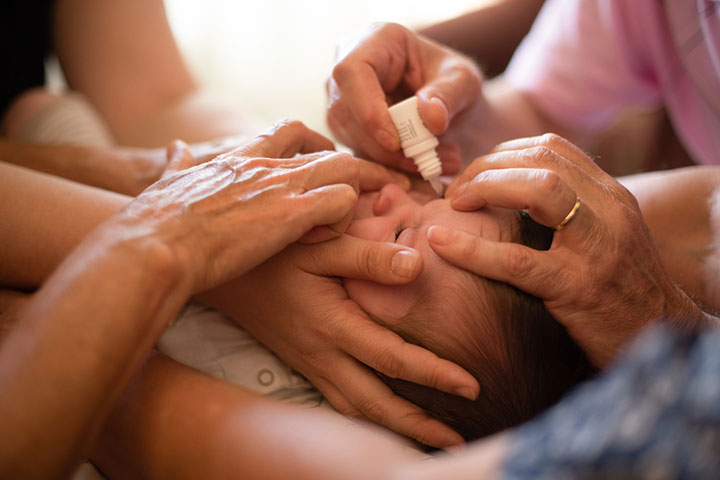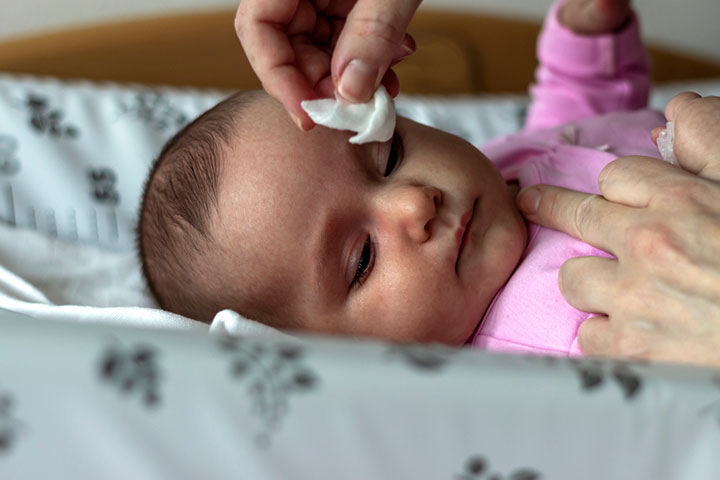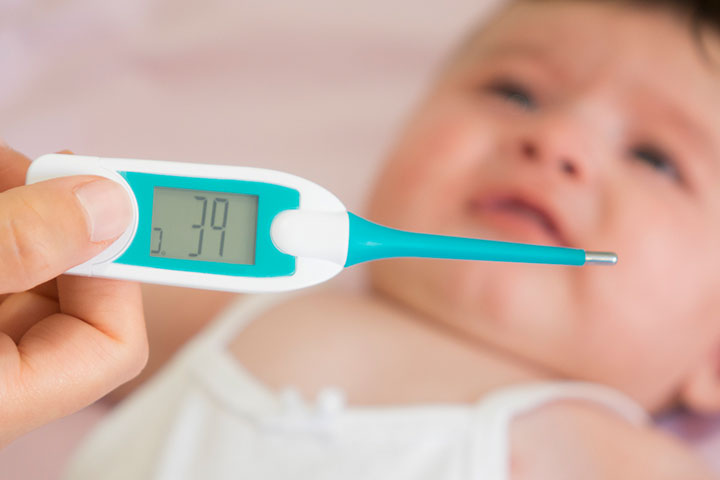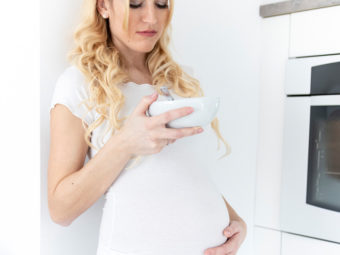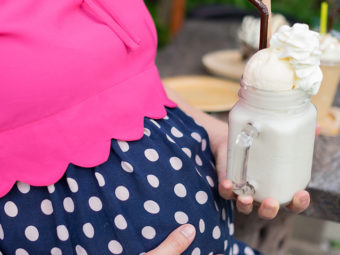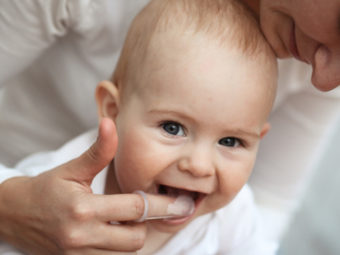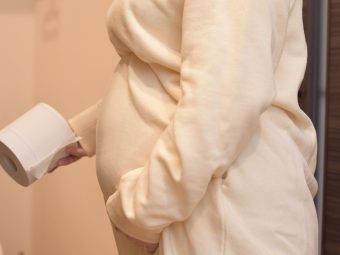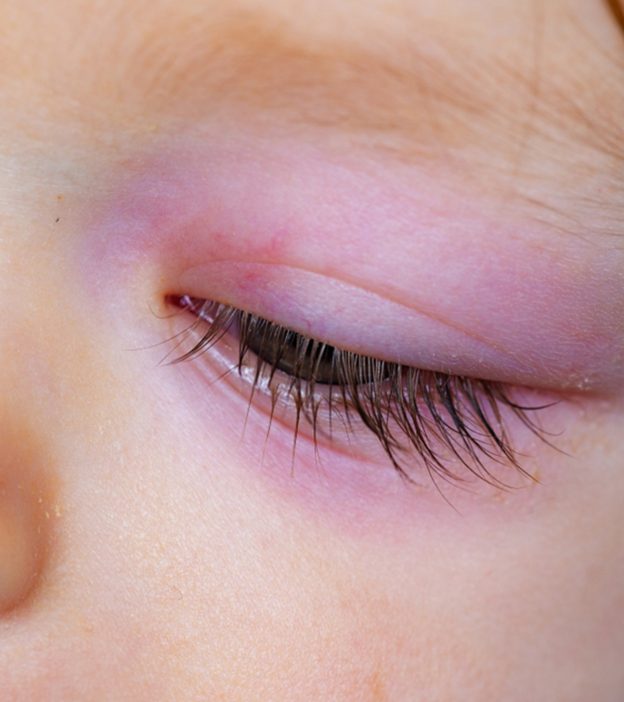
Image: Shutterstock
Swollen baby eyes can leave parents worried since eyes are delicate and essential organs. The swelling of the eyes can be of different intensities, depending on the underlying reasons. Sustained swelling may increase the risk of vision and other eye-related problems. Prompt identification and treatment can help improve outcomes and prevent complications.
Read this post to know about the various reasons, home remedies, and treatment options for swollen eyes in babies.
Severity Of Baby’s Swollen Eyes
The swelling in a baby’s eyes includes swelling in the tissues of the eyelids, eyeballs, and the orbits where the eyeballs are located. The severity of eye swelling in babies can be determined through the following scale (1).
- Mild swelling: The swelling is considered mild when the puffiness is limited to the eyelids, but they open normally.
- Moderate swelling: The eyes are more than puffy, but the eyes are still opening normally.
- Severe swelling: The swollen lids cause the eyes to shut or remain almost shut. There may also be swelling in the eyeball tissues, such as the conjunctiva and scleraiXThe white coating on the outer surface of the eyes that extended to the corners. (white of the eye).
What Causes Swelling In Baby’s Eyes?
There are several reasons for eye swelling, depending on whether one or both the eyes are affected (2).
Causes of swelling in one eye
- Rubbing the eye: It is common for babies to touch or rub their eyes with dirty hands. Dust and other irritants on the hands, such as food particles, may irritate the eyes, causing them to swell temporarily and become irritated.
- Insect bites: Insect bite on the periorbitaiXThe area that consists of the layer and tissues and surrounds the orbit. (region around the orbit or eye socket) or on the eyelid may lead to swollen baby eyes. Mosquito and ant bites are some common reasons.
- Allergies and contact dermatitis: Babies susceptible to allergies or related conditions, such as contact dermatitis (eczemai), may develop swollen and itchy eyes on contact with an allergen. Some common triggers are plants, insects, pollen, dust, and pet dander.
- Sty: Sty in babies could occur due to infection or blockage of oil gland ducts of the eyelid or the follicles of the eyelashes. The condition can cause a prominent boil on the affected eyelid. ChalazioniXPainful and irritating red bump on the eyelid. , which only affects the oil gland ducts, could also lead to the same results.
 Point to consider
Point to consider- Dacryocystitis: It is the infection of the lacrimal saciXA hollow structure near the inner corner of the eye, responsible for draining tears from the tear-producing glands into the nose. or the tear sac, which lies in the inner corner of the eye towards the nose. Bacteria are the most common cause of this infection.
- Blocked tear ducts: According to the American Academy of Ophthalmology, blocked ducts are prevalent among 20% of babies born in the US. The tear duct or the nasolacrimal duct drains the tears from the eyes to the nasal cavity. A blocked tear duct in babies could lead to crusty and swollen eyes. There are several reasons behind blocked tear ducts, including congenital anomaliesiXStructural or functional abnormalities that happen inside the womb and are present at birth. of the tear duct (3).
- Sinus infections: Sinuses lie between the nasal cavity and the eyes. Any infection in the sinuses may result in swelling around the eyes.
- Periorbital cellulitis: It is the infection of the tissue of the periorbita, the region around the eye socket. Bacteria are the most common causes of the infection (4).
Causes of swelling in both eyes
- Conjunctivitis: It is the inflammation of the conjunctiva, a thin membrane covering the inside of the eyelids and the sclera (white of the eye). The condition is commonly called pink eye. Conjunctivitis could occur due to bacterial or viral infections or as a result of an allergy, resulting in inflamed conjunctiva.
- Edema around the eyes: EdemaiXSwelling of the body parts due to excess fluid accumulation in bodily tissues. is the retention of fluid within body tissues, causing localized swelling. Periorbital edema could occur due to fluid accumulation around the eyes. It may result from serious underlying issues, such as kidney, liver, or heart problems. Nephrotic syndrome is a condition that causes too much protein to enter the kidneys, causing edema and swelling around the baby’s eye, especially after they wake from sleep (5).
- Anaphylaxis: It is a life-threatening allergic reaction, causing swollen body tissues, including eyes and eyelids. It is often accompanied by breathing or swallowing difficulty and skin hives. Certain food items, drugs, and the sting of some insects, such as bees, are common triggers.
 Be watchful
Be watchfulBesides these causes, an eye injury could also lead to swollen eyes in babies. If you notice swelling in one or both of the baby’s eyes after an injury, take your baby to a doctor immediately. If the injury is due to a chemical or substance entering the baby’s eyes, carry the container of the compound so that the healthcare providers may administer relevant antidote or remedy.
How Are Swollen Eyes In Babies Treated?
The treatment of swollen eyes depends on the cause and intensity of swelling. Mild and moderate swelling may not require any treatment. Severe swelling and some cases of swollen eyes may require the following treatment modalities.
- Antibacterial eye drops may be advised in case of bacterial conjunctivitis (6).
- Allergy-related swelling and conjunctivitis in the eye may require antihistamine drops and oral medication.
- Topical antibiotics may be prescribed for external eyelid swelling, such as due to a sty.
- Surgical correction of anomalies, such as tear duct blockage, may be needed in some cases.
- Serious infections, such as periorbital cellulitis, may require hospital admission and administration of intravenous antibiotics (7).
- Relevant treatment for other causes, such as nephrotic syndrome, may be needed to cure swollen eyes in some cases.
Home Remedies For Swollen Eyes In Babies
You may consider the following home remedies for mild to moderate eye swelling in babies (2).
- If swollen eyes are due to an insect bite, it is usually harmless and resolves by itself. If the baby seems uncomfortable, you may apply an ice pack or ice wrapped in a wet cloth to the affected eye for five minutes at a time for 20 minutes and alleviate any burning sensation (1).
- If your baby’s eye swelling is due to a sty, apply a warm compress for five minutes, three to five times a day. Use a clean washcloth each time.
- If your baby’s eye swelling is due to contact dermatitis or allergy, avoiding the substance is the best way to relieve the swelling and prevent it from recurring (7).
 Quick tip
Quick tipWhen To See A Doctor?
The swollen eyelids’ severity and associated symptoms should guide you to decide if you must call your doctor.
You must call your pediatrician and seek immediate care in the following cases (2).
- Severe swelling in one or both eyes
- Eye swelling is accompanied by a fever
- Eyelids or sclera appear red, swollen, and puffy
- Pus or watery liquid oozes from the eye
- Your baby shows signs of malaise or appears very sick
You may contact a pediatrician within 24 hours in the following cases.
- Baby has one or two swollen eyelids with no fever and no effect on the baby’s routine
- Sore or tender eyelids with no other symptoms
- Periorbital swelling (swelling around the eyes) but no other symptoms
- Redness and mild swelling of the sclera but no fever
- Cloudy vision
Frequently Asked Questions
1. Is it okay to put breastmilk in the baby’s eye?
Some research suggests breastmilk is as effective as other ophthalmic solutions for managing eye discharge. You should consult your baby’s pediatrician before putting breast milk in your baby’s eyes (8).
2. Can a baby’s eye infection go away on its own?
Eye infections in babies always need medical attention. In most cases, the doctor may prescribe antibiotic eye drops or ointments (9).
3. How long does it take for swollen eyes in babies to go away?
Swelling in a baby’s eyes may take anywhere from one to three days to go away, depending on the cause. However, it is recommended to consult a doctor if other symptoms appear after the initial 24 hours or if the condition persists beyond the three-day period with no other symptoms (2).
Swollen baby eyes are often caused by allergies, insect bites, sty, rubbing of eyes, or blocked tear ducts. Usually, allergies and conjunctivitis cause swelling in both eyes, and other conditions can be limited to one eye. The severity of swelling may vary from mild to severe, that is, from puffiness of eyes to closed eyes due to eyelid swelling. Although it can be worrisome for parents, most babies get better with simple home care measures. Eye drops and ointments are prescribed for most babies with swollen eyes, and if there is an anatomical abnormality, surgical correction is recommended.
Infographic: Interpreting Causes And Tips To Prevent Eye Swelling In Babies
Swelling in the baby’s eyes could be due to minor to more serious medical reasons, and understanding them may help relieve the swelling faster. Explore more about the indications behind the common causes and simple preventive measures for baby’s eye swelling in the infographic below. Illustration: Momjunction Design Team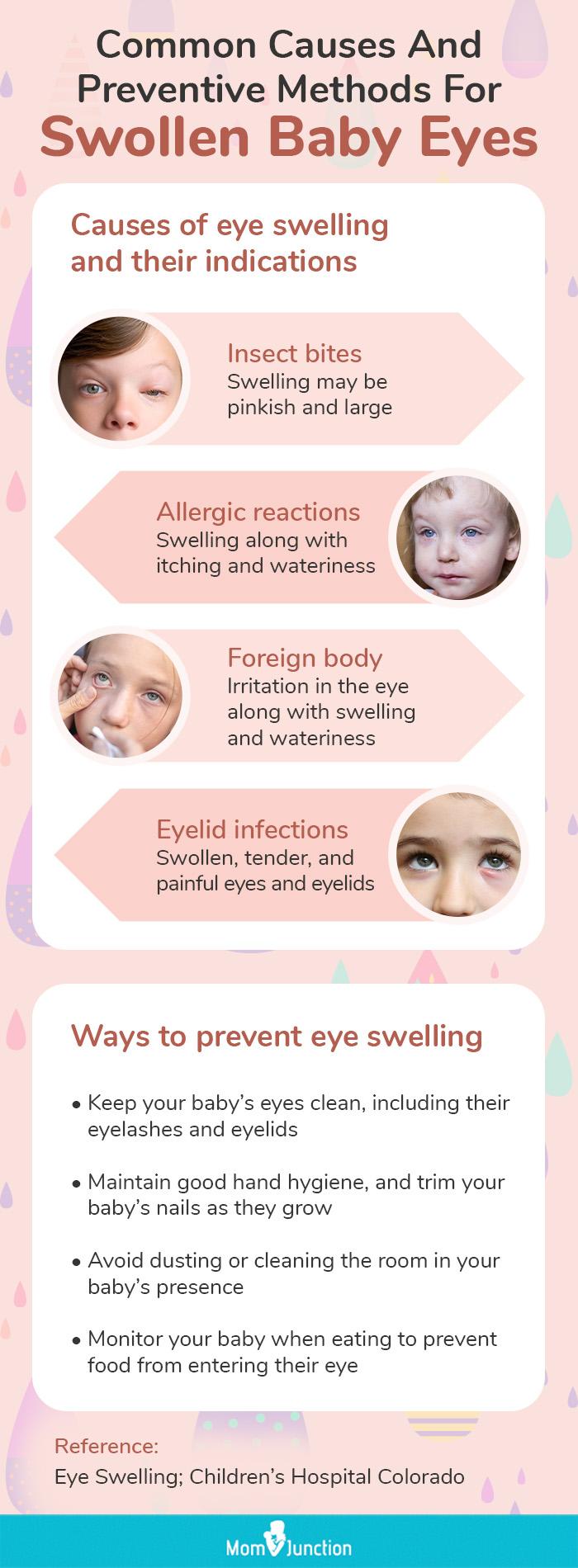
Get high-quality PDF version by clicking below.
Download Infographic
Key Pointers
- Depending on the severity, swollen eyes in babies can be mild, moderate, or severe.
- Swelling in one eye may be caused by insect bites or allergies, while swelling in both the eyes may be due to conjunctivitis or edema.
- Treatment of swollen eyes may include antibacterial eye drops, topical antibiotics, surgical corrections, and more.
- Mild or moderate swelling can be treated with home remedies such as ice packs or warm compresses.
- Consult a doctor if the baby has severe symptoms, including fever with swelling, pus oozing from the eye, or pain in the eyelids.
References:
2. Eye Swelling; Seattle Children’s Hospital
3. Blocked Tear Ducts; C. S. Mott Children’s Hospital
4. Cellulitis of the Eye in Children; University of Rochester Medical Center
5. Childhood Nephrotic Syndrome; National Kidney Foundation
6. Conjunctivitis in Children; Stanford Children’s Health
7. Art Papier, David Tuttle, and Tara J. Mahar, Differential Diagnosis of Swollen Red Eyelid; American Family Physician
10. Stye; Raising Children Network
11. Eye Swelling; HealthyChildren.org







